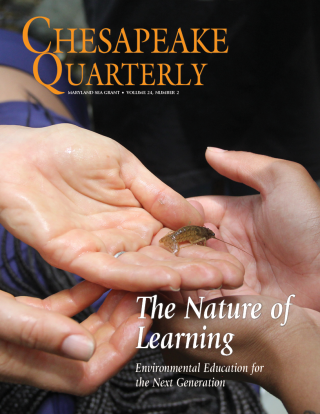Knauss legislative fellowships in Congress help build careers — and they're fun and educational. See our video and fact sheet for details.
The Maryland Sea Grant Bookstore will be closed for the winter holidays from Monday, December 15th to Friday, January 2nd and will not be taking orders during that time.
R/CBT-39
Abundance and Variety of Microplastics in Surface Waters, Sediments, and Oysters: Relationship to Point-Sources and Land Use Practices
Principal Investigator:
Lance YonkosStart/End Year:
2018 - 2020Institution:
University of Maryland, College ParkCo-Principal Investigator:
Carys Mitchelmore, Chesapeake Biological Laboratory, University of Maryland Center for Environmental Science; Johan Schijf, Chesapeake Biological Laboratory, University of Maryland Center for Environmental ScienceTopic(s):
- Oysters
Strategic focus area:
Healthy coastal ecosystemsDescription:
The eastern oyster, Crassostrea virginica, has historically been a species of tremendous importance to the Chesapeake Bay economically and ecologically and provides numerous ecosystem services, including water filtration, habitat and food for many other Bay species. Significant hatchery and aquaculture efforts are currently underway to recapture the economic and ecological benefits of a robust oyster population within Chesapeake waters, whether for human consumption or to promote improvements in water quality and benthic habitat. The presence of microplastics (MP) in Bay waters may negatively impact these efforts. Oysters are known to ingest MP and studies have shown negative impacts to their health and reproduction, which could impede the goal of establishing self-sustaining populations. Furthermore, the retention of MP (and associated sorbed contaminants) could have trophic transfer implications, including to humans. Conversely, oysters may function to cleanse Chesapeake Bay waters of MP just as they filter and deposit suspended sediments. This will remove MPs from the pelagic system but potentially increase exposure for benthic organisms. Exposure of oysters to MP will differ by region depending on land use characteristics (e.g., population density, imperviousness point-source discharges, etc.) and hydrologic conditions. There may also be unrealized consequences of MP abundance, type, and location to oyster restoration and aquaculture efforts in the sense that MP exposure may differ between floating and on-bottom aquaculture systems. We propose a two-year project to quantify the abundance and variety of MP within Chesapeake Bay water, sediment, and oysters, and to investigate the influence of location on oyster exposure to and uptake of MP, both within the water column and in proximity to different sources of MP introduction and land use characteristics (i.e., WWTPs, urban, suburban or agricultural inputs). Waters, sediments, and oysters will be sampled at these varying locations. Surface, mid-depth, and bottom waters will be simultaneously collected at various tidal stages to investigate influence on MP abundance. Archived Chesapeake Bay surface sediment samples from 1980-81 will be compared to current samples to investigate change in MP abundance, size, shape and polymer-type over the past 3+ decades. Such an historic perspective cannot always be obtained from modern core records due to extensive vertical mixing of sediment from dredging activities in locations where MP are most likely to be abundant (e.g., Baltimore Harbor). Management and conservation decisions concerning locations of aquaculture facilities or sanctuary reefs will benefit from an improved understanding of actual exposure-related risks of MP to oysters. This study will be performed jointly at the University of Maryland in College Park and at the Chesapeake Biological Laboratory in Solomons. The effort will be supported by multiple undergraduate laboratory workers and by REU students (supported by NSF) under supervision of the three project PIs. Project partners from state (DNR) and federal (NOAA) agencies, academia (UMCES), and non-profit/community based organizations (Chesapeake Bay Foundation, Living Classrooms, Trash Free Maryland, etc.) will provide broad outreach to stakeholders involved in restoration of Chesapeake Bay oyster populations as well as promotion of commercial aquaculture.





